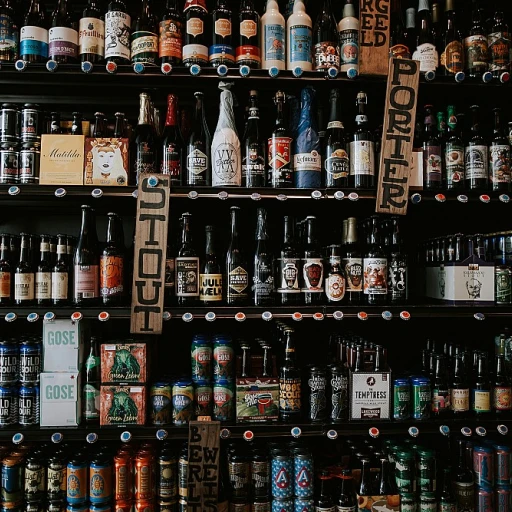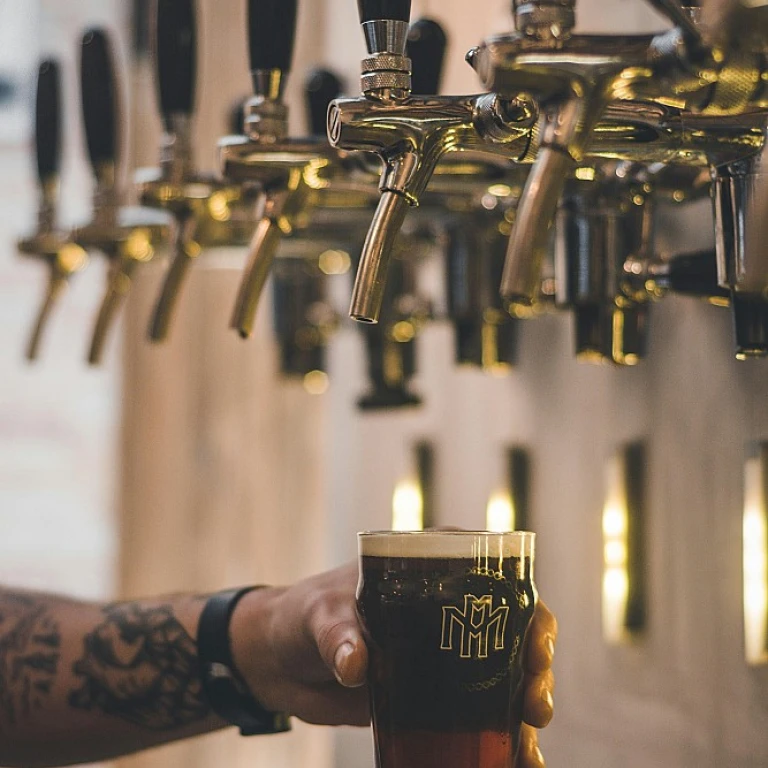The Origins of Ballantine Ale
Tracing the Roots of a Timeless Ale
The story of Ballantine Ale begins in the bustling streets of Newark, New Jersey, where the legendary beer was born in the early 19th century. Founded by Scottish immigrant Peter Ballantine, the brewing company quickly established itself as a formidable player in the American brewing scene. Peter Ballantine's keen sense for quality and tradition meant that his ales were brewed to the highest standards, setting the foundation for what would become a storied American legacy.
Ballantine Ale became synonymous with craftsmanship and excellence at a time when many emerging breweries sought to carve out a unique identity. The ale quickly gained notoriety, with its popularity spreading across the eastern United States, largely due to its distinctive flavor profiles and brewing methods — elements that we will delve deeper into in later sections.
What set Ballantine Ale apart was not only the foresight of its founder but also the brewing techniques that deviated from the norm. Unlike wineries or breweries that adhered strictly to traditional methods, Ballantine's operations were marked by innovation and bold experimentation, attributes that played an essential role in its rise to fame.
As the first part of our journey through Ballantine's history unfolds, it is clear that both the man and the beer left an indelible mark on the American beer landscape. For a further look into the evolving trail of legendary brews, consider the stories behind other iconic beverages, such as
the mad dog beer saga, which also contributed to shaping the beer culture we know today.
This exploration of Ballantine's origins offers a glimpse into a bygone era of brewing, setting the stage for understanding the profound impact Ballantine Ale has had — and continues to have — on American beer culture, as we will explore in the forthcoming parts.
Brewing Techniques and Ingredients
Traditional Brewing Techniques
Ballantine Ale has long been celebrated not only for its distinctive taste but also for the dedication to traditional brewing techniques that set it apart. Unlike many modern beers that rely on speed and efficiency, Ballantine's brewers committed to a process that was as much about craftsmanship as it was about science.
Among the key elements that define Ballantine's brewing approach is their hop selection and usage. The aromatic bouquet that defines Ballantine Ale comes from a carefully curated mix of hops. Hops are not just used for bitterness but are meticulously selected for their distinct character and aroma, ensuring a unique flavor profile that has captured the loyalty of beer enthusiasts for generations.
In addition, Ballantine Ale employs a historical technique known as "dry-hopping," which involves adding hops to the beer during fermentation. This method enhances the aroma without adding too much extra bitterness, a hallmark that can be traced back to its influence on early American IPAs. This technique, although labor-intensive, results in a complex yet balanced ale that speaks to both its rich history and meticulous production process.
Equally crucial to the beer's iconic status is the use of wood-aging. At a time when industrialization was driving beer production towards metal vats, Ballantine stuck with the method of aging their ale in oak, which imparted a distinct flavor and depth that cannot be replicated by more modern methods. This choice in materials used underscores a dedication to authenticity and quality that remains revered in brewing circles today.
These traditional methods not only contribute to the rich, multi-layered taste that Ballantine Ale is known for but also solidify its place in American beer folklore. As we journey through the legacy of Ballantine Ale, these techniques continue to underscore its role as not just a beverage, but a carefully crafted symbol of brewing heritage.
Ballantine's Impact on American Beer Culture
The Resounding Influence on American Breweries
Ballantine Ale stands as a cornerstone in the chronicles of American brewing culture, casting a long shadow over the landscape of beer production in the United States. This ale established itself not merely through its distinctive taste, but also by defining parameters of quality and aroma that many breweries aspired to emulate.
As discussed earlier, the unique blend of ingredients and techniques championed by Ballantine Ale carved out a niche market, setting new benchmarks for what a robust ale should embody. This innovation didn't go unnoticed. Breweries across America took inspiration from Ballantine, aiming to replicate its success by exploring bold, rich flavors crafted through meticulous brewing processes.
In tracing the ale's inception, we saw how it emerged from humble beginnings to become an American staple, renowned for its technique and tradition. These early foundations provided the springboard for its pervasive influence, as Ballantine Ale introduced a new dimension of creativity to beer crafting.
Beyond its immediate allure, Ballantine Ale left an indelible mark on the minds and palates of beer enthusiasts and connoisseurs. Its legacy not only informed the brewmasters of the day but also sowed the seeds for the future explosion of the craft beer movement. By promoting a culture of innovation, Ballantine encouraged an American beer scene that thirsted for experimentation and authenticity, qualities that continue to define the industry today.
For those interested in how iconic elements of beer culture permeate other aspects, exploring
vintage beer apparel offers a fascinating glimpse into how Ballantine—and other historical brews—continue to shape the culture and community that celebrates them.
The Role of Ballantine in the IPA Revolution
The Catalyst for Innovation in the IPA Scene
Ballantine Ale played a pivotal role in what we now know as the IPA revolution. While the story of Ballantine Ale begins with its rich heritage and unique brewing techniques, its influence on the burgeoning American craft beer scene cannot be understated. As we delve into how Ballantine became an unexpected champion for a burgeoning category, it's essential to recognize how its iconic hop character laid the foundational notes for many IPAs that followed.
In its heyday, Ballantine Ale was lauded for a bold hop profile that was rather groundbreaking for its time. This distinctive feature, which combined aromatic hops with a perfectly balanced malt backbone, helped set the stage for brewers looking to push the boundaries of typical ale production. The ale's full-bodied flavor and pronounced bitterness encouraged brewers to explore more adventurous hop-forward recipes, gradually popularizing what would become a prominent segment of the beer market.
Today, as we look back at Ballantine's contribution to the IPA narrative, we see a brand that not only captured hearts with its unique profile but also inspired future generations. From the local craft breweries experimenting with hops to the grand IPA displays we witness in beer festivals around the world, traces of Ballantine's innovative spirit remain unmistakable. Its influential legacy persists, carving a lasting impression on the IPA evolution and further cementing Ballantine Ale's role as a trailblazer in beer history.
Ballantine's Legacy and Modern Revival
The Enduring Influence of Ballantine in Modern Beer
As we journey through the rich history of Ballantine Ale, it's clear that its legacy is more than just historical nostalgia; it's an enduring influence that continues to resonate in today's beer landscape. Known for its innovative ideas and distinctive brewing techniques, Ballantine paved the way for many trends that continue to shape the modern craft beer movement.
Ballantine Ale left an indelible mark on American beer culture. Its unique approach to brewing, which was explored through its pioneering techniques and choice of ingredients, laid the groundwork for a resurgence of interest in traditional brewing methods. This resurgence became particularly noticeable with the craft beer renaissance of the late 20th and early 21st centuries, where authenticity and quality became paramount.
Moreover, as the craft beer market expanded, many breweries sought inspiration from Ballantine's meticulous attention to flavour balance and hop selection. This inspiration was instrumental in steering the IPA revolution, where the quest for bold flavors became a defining characteristic. Ballantine's commitment to using the finest hops not only influenced the flavor profiles of these beers but also elevated consumer expectations around what an IPA could offer.
Today, the revival of Ballantine Ale speaks volumes about its lasting appeal. Enthusiasts of the brand and new generations of beer lovers alike appreciate the authenticity and quality that Ballantine represents. Breweries attempting to emulate its success often find themselves embracing a blend of traditional and innovative brewing practices, ensuring that Ballantine's influence remains a cornerstone of the beer industry.
In summary, Ballantine Ale's legacy is a testament to its pioneering spirit and ability to influence generations of beer drinkers and makers. It remains a symbol of quality and innovation, inspiring brewers and enthusiasts to continue evolving the industry while honoring its rich heritage.
Tasting Ballantine Ale Today
Rediscovering the Modern Palate of Ballantine Ale
As we journey back to the flavors of Ballantine Ale, it’s like tapping into a time capsule of American brewing heritage. The complex profile that once defined it was as much about tradition as innovation, resonating with the passion Arthur Ballantine poured into his brewing pursuits. Today, tasting Ballantine Ale unveils a brew that balances nostalgia with contemporary craft aspirations.
The rich malt character remains a testament to the classic brewing techniques and ingredients laid out in its origins. This enduring appeal is enhanced by the bold hops that contributed significantly to the early IPA revolution, creating a harmony that aficionados and newcomers alike can appreciate.
For those who sample Ballantine Ale in its current form, the experience is a blend of familiar and novel elements. You may notice a distinctive flavor profile that hints at its historical roots, yet offers surprises that align with today’s artisanal trends.
Each sip is a reminder of Ballantine's influential role in American beer culture, stimulating conversations around its legacy and the modern craft movement. It bridges generations of beer enthusiasts, inviting them to appreciate the rich tapestry of flavors that have been brewed and reborn through the craft beer renaissance. Brewing innovations and historical allure continue to color Ballantine Ale's palate, making it a unique choice for those who cherish both heritage and modernity in their beer-tasting experiences.


